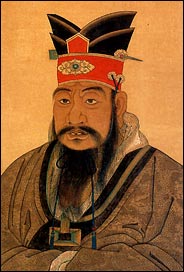|
January 1, 2004 Bringing the Historical Confucius to LifeBy ALAN RIDING
Now the Musée Guimet in Paris, renowned for its fine collection of Asian art, has set out to bridge this gap between East and West by devoting an exhibition to this central pillar of Asian thought. Even so, it is no easy task to translate the teacher's life into an art show when only his words from the 6th century B.C. survive. But here the Guimet's curators had a brain wave: to give a sense of narrative, they invited the Paris-based Chinese calligrapher and painter Ye Xin to interpret key moments in Confucius' life in 30 lively color sketches. What Confucius actually looked like of course remains a mystery. The traditional representation of him as a bearded man wearing a gown and a ceremonial hat is based on the imagination of artists working 1,500 to 2,000 years after his death. This show includes a 1691 red ink print of a stone engraving dated 1118 and three silk screen paintings, two portraying him with disciples, made during the Ming dynasty (1368-1644). Of his life, more is known. Kung-tzu or Kung-fu-tzu — Westernized as Confucius — was born in 551 B.C. in Chufu, in what is today eastern Shandong province. By all accounts, he was a man devoted to learning — in his words, "for the sake of the self" — as well as to teaching, with emphasis on self-improvement and moral rectitude. Eager to preserve and perpetuate ancient learning, he set out to master the six arts: ritual, music, archery, charioteering, calligraphy and arithmetic. But he also felt a calling for public service, initially establishing a system of examinations to prepare young nobles for responsible leadership and later serving as a magistrate, a public works official and finally as justice minister in the Lu kingdom. In the eyes of scholars, the most reliable sources of information are the records of Confucius' own conversations, transcribed in 20 "books" by his closest followers after his death at 73. In Book 2, Verse 4, of the Analects, he is quoted as summarizing his life in typically philosophical terms: "The Master said, `At 15, I had my mind bent on learning. At 30, I stood firm. At 40, I had no doubts. At 50, I knew the decrees of Heaven. At 60, my ear was an obedient organ for the reception of truth. At 70, I could follow what my heart desired, without transgressing what was right." The Guimet show, "Confucius: At the Dawn of Chinese Humanism," which runs through Feb. 29 before traveling to the Caixa Forum in Barcelona, seeks to place Confucius in his time, and starts with a display of beautifully designed bronze cups, vases and containers, variously dated between the 12th and 7th centuries B.C., all of which underline the sophistication of the society into which Confucius was born. And so no less than those who worship ancestors in China today, Confucius had good reason to be in awe of his own ancestors and to show determination to preserve their rituals and knowledge. To illustrate the arts, or disciplines, that sustained Confucius' philosophy, the exhibition offers two carillons, one comprising eight slices of stone, the other nine bronze bells, to represent music; a bronze bow and an archer's protective ring to represent archery; a stunning ancient bronze horse and cart, the horse's head standing six feet from the ground, to represent charioteering; and a terra-cotta ink container in the form of a turtle to represent calligraphy. One of Confucius' principal legacies was the notion of the enlightened civil servant, a concept that centuries later would spawn the system of all-powerful mandarins. On display are two sandstone statues of sixth-century dignitaries; ceramic figures of civil servants; a large silk-screen portraitait of "the Venerable Qi Jiguang," a celebrated 16th-century military strategist; and ceremonial robes of descendants of Confucius (all on loan from the Provincial Museum of Shandong in Jinan). Connecting this past to a more modern era, the Guimet presents photographs taken by French expeditions in 1907 and 1914 at the temple and tomb of Confucius at Chufu. But while Confucianism has a strong following in South Korea, Japan, Singapore and Vietnam as well as in China and Taiwan, it has had its ups and downs in its homeland, not least early in the 20th century when it was blamed for China's backwardness, and during the Cultural Revolution of the late 1960's and early 1970's when it again came under attack. Since 1989, however, it has been embraced afresh by Beijing as an authentically Chinese answer to Western political culture. Writing in this show's catalog, Danielle Elisseeff, a China scholar
at France's School of Advanced Studies in the Social Sciences, said
that part of Confucius' appeal lies in the multiple interpretations
of his thoughts and life. Just as some say he personified the goodness
of human nature and the value of teaching, she noted, others believe
he served to justify strong rules and law. Yet if he remains "an incomparable
figure of reference," she said, it is because "for so long he has nourished
the hopes of so many people." |

